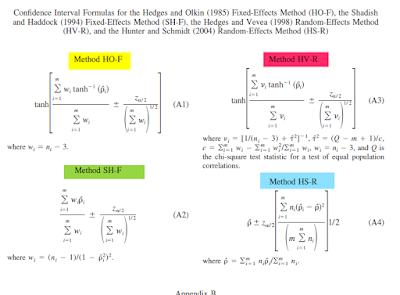Yes. It's another blog about correlation coefficients. I make no apology for that. I estimate that - much like the old English adage about rats - you're never more than six feet away from a Pearson's r in personality and social psychology.
 |
I did some digging and it turns out that there's at least 5 different methods in the literature. I know this thanks to a great paper by Professor Doug Bonnet, in which 5 methods are pitted against each other with a simulation study. It's s a kind of meta-analytic royal rumble. Which are my words, not Professor Bonnet's - I doubt that framing would have gone down well at the journal. Here's that paper, courtesy of Professor Bonnet's Researchgate.
The contenders were HO-F, SH-F, HV-R, HS-R:
And a new method proposed by Bonnet, a mysterious newcomer simply known as equation 4.
Where p hat, the unweighted average of the sample correlations, is:
And where variance of tanh^-1(p hat):
Now, I fully understand that this equation will look a little alien to some. But I have scripted it in R, so that you can play along with the computational example given on page 177. As per usual, this script can be extremely easily modified to use with your own data to create confidence intervals for your own meta-analysed rs. The script is a bit flabby I expect. People that have been coding in R longer than me will almost definitely spot some redundancy, but it get's you the desired result. Click here, or scroll to the bottom of this blog post.
All you have to do is:
- Enter your correlations in the cors <- c(.......) part.
- Enter the n for each correlation in the ns <- c(.......) part.
- Enter the number of correlations in the m <- x part.
Here's the code (thanks to Daniel Lakens for suggesting I use gist, here's his blog):






No comments:
Post a Comment